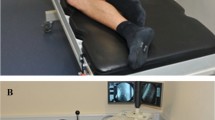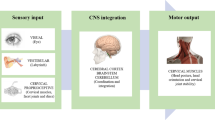Abstract
The purpose of this study was to provide a thorough description of lumbar surface integrated electromyography (EMG) in pain-free normals during a standardized assessment protocol of static isometric and unresisted dynamic tasks. It has been proposed that in pain-free normals, symmetrical tasks that bend the trunk forward or extend the trunk backward produce symmetrical paraspinal EMG activity, and asymmetrical tasks that rotate or laterally bend the trunk produce asymmetrical paraspinal EMG activity. In addition, it has been observed that lumbar EMG assessment during static tasks has been more consistent than tasks involving dynamic activities. Twenty-eight pain-free normals were assessed during symmetrical and asymmetrical tasks in both static and dynamic activities in a counterbalanced manner. The assessment of paraspinal EMG patterns was conducted while subjects were secured in a triaxial dynamometer, which provided standardization of body position and concurrent measurement of torque, range of motion, and velocity. The results provided experimental evidence for the above-stated propositions. An implication derived from this research is that clinicians may be better served utilizing local norms when using EMG for classification purposes.
Similar content being viewed by others
References
Ahern, D. K., Follick, M. J., Council, J. R., & Laser-Wolston, M. A. (1986). Reliability of lumbar para-vertebral EMG assessment in chronic low back pain.Archives of Physical Medicine and Rehabilitation, 67 762–765.
Arena, J. G., Sherman, R. A., Bruno, G. M., & Young, T. R. (1989). Electromyographic recordings of five types of low back pain subjects and nonpain controls in different positions.Pain, 37 57–65.
Arena, J. G., Sherman, R. A., Bruno, G. M., & Young, T. R. (1990). Temporal stability of paraspinal electromyographic recordings in low back pain and non-pain subjects.International Journal of Psychophysiology, 9 32–37.
Arena, J. G., Sherman, R. A., Bruno, G. M., & Young, T. R. (1991). Electromyographic recordings of low back pain subjects and nonpain controls in six different positions: Effect of different pain levels.Pain, 45 23–28.
Basmajian, J. V., & Blumenstein, R. (1989). Electrode placement in electromyographic biofeedback. In J. V. Basmajian (Ed.),Biofeedback: Principles and practice for clinicians (pp. 369–382). Baltimore, MD: Williams & Wilkins.
Cassisi, J. E., Robinson, M. E., O'Connor, P., & MacMillan, M. (1993). Trunk strength and lumbar paraspinal EMG during isometric exercise in chronic low back pain patients and controls.Spine, 18 245–251.
Chastain, D. C., Cassisi, J. C., Wilner, B. I., Knecht, H., & Keenum, M. (1992, November).The use of EMG to measure localized muscle fatigue. Paper presented at the meeting of the Association for Advancement of Behavior Therapy, Boston.
Collins, G. A., Cohen, M. J., Naliboff, B. D., & Schandler, S. L. (1982). Comparative analysis of paraspinal and frontalis EMG, heart rate and skin conductance in chronic low back pain patients and normals to various postures and stress.Scandinavian Journal of Rehabilitation Medicine, 14 39–46.
Cram, J. R., & Steger, J. C. (1983). EMG scanning in the diagnosis of chronic pain.Biofeedback and Self-Regulation, 8 229–241.
Dillard, J., Trafimow, J., Andersson, G. B. J., & Cronin, K. (1991). Motion of the lumbar spine: Reliability of two measurement techniques.Spine, 16 321–324.
Dolce, J. J., & Raczinski, J. M. (1985). Neuromuscular activity and electromyography in painful backs: Psychological and biomechanical models in assessment and treatment.Psychological Bulletin, 97 502–520.
Donaldson, S., & Donaldson, M. (1990). Multi-channel EMG assessment and treatment techniques. In J. R. Cram & Associates (Eds.),Clinical EMG for surface recordings (Vol. 2, pp. 143–173). Nevada City, CA: Clinical Resources.
Hoyt, W. H., Hunt, H. H., De Pouw, M. A., Bard, D., Shaffer, F., Passias, J. N., Robbins, D. H., Runyon, D. D., Semrad, S. E., Symonds, J. D., & Watt, K. C. (1981). Electromyographic assessment of chronic low-back pain syndrome.Journal of the American Osteopathic Association, 80 57–59.
Kirk, R. E. (1982).Experimental design. Pacific Grove, CA: Brooks/Cole Publishing.
Lofland, K. R. (1994). Somatic amplification in chronic low-back pain patients: Development of a multimodal assessment battery (Doctoral dissertation, Illinois Institute of Technology, 1994).Dissertation Abstracts International, 55-02B, 599.
McGill, S. M. (1991). Electromyographic activity of the abdominal and low back musculature during the generation of isometric and dynamic axial trunk torque: Implications for lumbar mechanics.Journal of Orthopaedic Research, 9 91–103.
Nouwen, A., & Bush, C. (1984). The relationship between paraspinal EMG and chronic low back pain.Pain, 20 109–123.
Nouwen, A., Van Akkerveeken, P. F., & Versloot, J. M. (1987). Patterns of muscular activity in patients with chronic low back pain.Spine, 12 777–782.
Parnianpour, M., Li, F., Nordin, M., & Kahanovitz, N. (1989). A database of isoinertial trunk strength tests against three resistance levels in sagittal, frontal, and transverse planes in normal male subjects.Spine, 14 409–411.
Parnianpour, M., Nordin, M., Kahanovitz, N., & Frankel, V. (1988). The triaxial coupling of torque generation of trunk muscles during isometric exertions and the effect of fatiguing isoinertial movements on the motor output and movement patterns.Spine, 13 982–992.
Price, J. P., Clare, M. H., & Ewerhardt, R. H. (1948). Studies in low backache with persistent muscle spasm.Archives of Physical Medicine and Rehabilitation, 29 703–709.
Roy, S. H., DeLuca, C. J., & Casavant, D. A. (1989). Lumbar muscle fatigue and chronic lower back pain.Spine, 14 992–1001.
Sherman, R. A. (1985). Relationships between strength of low back muscle contraction and intensity of chronic low back pain.American Journal of Physical Medicine, 64 190–200.
Wolf, S. L., Basmajian, J. V., Russe, T. C., & Kutner, M. (1979). Normative data on low back mobility and activity levels.American Journal of Physical Medicine, 58 217–229.
Wolf, S. L., Nacht, M., & Kelly, J. L. (1982). EMG feedback training during dynamic movement for low back pain patients.Behavior Therapy, 13 395–406.
Author information
Authors and Affiliations
Additional information
The authors would like to thank Allen Wolach, Ph.D. for his statistical consultation.
Rights and permissions
About this article
Cite this article
Lofland, K.R., Mumby, P.B., Cassisi, J.E. et al. Assessment of lumbar EMG during static and dynamic activity in pain-free normals: Implications for muscle scanning protocols. Biofeedback and Self-Regulation 20, 3–18 (1995). https://doi.org/10.1007/BF01712763
Issue Date:
DOI: https://doi.org/10.1007/BF01712763




